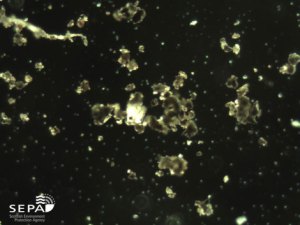Webcams Show Heightened Activity
Eruption at Eyjafjallajökull has steadily Intensified in the past 3 hours
Eyjafjallajökull has resumed explosive activity in the past 3 hours, having earlier slowed down to sporadically ejecting single plumes of ash once every 2 to 3 minutes.
The following are latest images obtained from two webcams that are trained on Eyjafjallajökull at Valahnúk and Hvolsvelli stations. The images show a constant stream of ash, steam and fumes spewed from the Icelandic volcano.The images are provided by Míla ehf and may be subject to copyright.

Valahnúk Webcam freeze frame of Eyjafjallajökull at 08:55UTC .

Hvolsvelli Webcam Image of Eyjafjallajokull also recorded at 08:55UTC.
The following irregular sequence of images were recorded from Hvolsvelli Webcam.

[L-R and T-B] Freeze frames shows a large plume of ash, steam and gasses ejected from the volcano just after sunrise at 5;16UTC on April 17, 2010. The ash plume seen in the first frame above dispersed (second frame) within minutes of being ejected from Eyjafjallajokull; however, after a series of explosions that occurred about 30 seconds later, another plume was ejected out of the volcano’s crater. The new plume seemed to be slightly larger than the previous one. Click image to enlarge.
Another sequence of images recorded simultaneously from Hvolsvelli and Valahnúk Webcams.

[T – B] The above freeze frames were recorded at about 5:31UTC, showing single plumes of ash and gasses ejected from Eyjafjallajokul. Click image to enlarge.

[T – B] The above freeze frames were recorded at about 5:35UTC. Most of the frames show two plumes, indicating a gradual increase in the frequency of eruptions at Eyjafjallajokul. Click image to enlarge.

This frame was recorded at 5:40UTC showing 3 plumes which meant the eruptions at Eyjafjallajokul had further intensified. Click image to enlarge.
- For previous updates and various related links click Eyjafjallajökull – UPDATE Apr 17
- Eruption Video April 17, 2010
.
Serial No 1,586. Starting April 2010, each entry on this blog has a unique serial number. If any of the numbers are missing, it may mean that the corresponding entry has been blocked by Google/the authorities in your country. Please drop us a line if you detect any anomaly/missing number(s).















